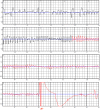Effective treatment of electrical storm by a wearable cardioverter defibrillator in a patient with severely impaired left ventricular function after myocardial infarction: a case report
- PMID: 33993888
- PMCID: PMC8126431
- DOI: 10.1186/s13256-021-02833-2
Effective treatment of electrical storm by a wearable cardioverter defibrillator in a patient with severely impaired left ventricular function after myocardial infarction: a case report
Abstract
Background: The implantation of cardioverter defibrillators (ICDs) is an established therapy in the prevention of sudden cardiac death in patients with systolic dysfunction after myocardial infarction. To avoid immediate implantation of an ICD, wearable cardioverter defibrillator vests (WCD) can be used to protect patients against malignant rhythm disorders, while at the same time drug-based heart failure therapy has to be initiated. This drug therapy can improve left ventricular ejection fraction and primary prophylactic cardioverter defibrillator implantation may not be necessary. However, the recent Vest Prevention of Early Sudden Death Trial (VEST) questioned the regular use of the WCD in this setting.
Case presentation: A 47-year-old Caucasian man with severely impaired left ventricular function early after myocardial infarction was prescribed a WCD as primary prophylaxis to prevent sudden cardiac death. Seven days after the patient was supplied with a WCD, the patient suffered from an electrical storm with recurrent ventricular tachycardia (VT), which was successfully terminated 17 times by the WCD. On coronary angiography, the formerly infarct-related right coronary artery had TIMI (Thrombolysis in Myocardial Ischemia Trial) III flow, and a remaining stenosis in the left anterior descending artery (LAD) was stented, which did not stop recurrent VT. In the electrophysiology (EP) study, a focus was mapped in the left inferior ventricle, which was ablated. This stopped the VT. A second radio-frequency (RF) ablation in the same area was necessary after 14 days. Finally, a permanent cardioverter defibrillator was implanted.
Conclusion: We report the case of a patient who survived recurrent episodes of VT early after myocardial infarction by effective defibrillation with a WCD. The WCD is a useful device to bridge time until a final decision for implantation of a defibrillator.
Keywords: Electrical storm; Post-myocardial infarction; Ventricular tachycardia; Wearable cardioverter defibrillator.
Conflict of interest statement
The authors declare that they have no competing interests.
Figures




Similar articles
-
Wearable cardioverter-defibrillator use in patients perceived to be at high risk early post-myocardial infarction.J Am Coll Cardiol. 2013 Nov 19;62(21):2000-2007. doi: 10.1016/j.jacc.2013.05.086. Epub 2013 Jul 31. J Am Coll Cardiol. 2013. PMID: 23916930
-
Wearable cardioverter defibrillator after cardiac surgery: Analysis of real-life data from patients at transient risk of sudden cardiac death.Ann Noninvasive Electrocardiol. 2023 Mar;28(2):e13048. doi: 10.1111/anec.13048. Epub 2023 Feb 1. Ann Noninvasive Electrocardiol. 2023. PMID: 36723848 Free PMC article.
-
Therapy optimization in patients with heart failure: the role of the wearable cardioverter-defibrillator in a real-world setting.BMC Cardiovasc Disord. 2018 Mar 15;18(1):52. doi: 10.1186/s12872-018-0790-8. BMC Cardiovasc Disord. 2018. PMID: 29544442 Free PMC article.
-
Risk stratification for implantable cardioverter defibrillator therapy: the role of the wearable cardioverter-defibrillator.Eur Heart J. 2013 Aug;34(29):2230-42. doi: 10.1093/eurheartj/eht167. Epub 2013 May 31. Eur Heart J. 2013. PMID: 23729691 Review.
-
Sudden cardiac death while waiting: do we need the wearable cardioverter-defibrillator?Clin Res Cardiol. 2022 Nov;111(11):1189-1197. doi: 10.1007/s00392-022-02003-4. Epub 2022 Mar 19. Clin Res Cardiol. 2022. PMID: 35305126 Free PMC article. Review.
Cited by
-
Wearable Cardioverter Defibrillator as a Treatment in Patients with Heart Failure of Various Aetiologies-A Series of Ten Cases Within the BIA-VEST Registry.J Clin Med. 2024 Dec 17;13(24):7686. doi: 10.3390/jcm13247686. J Clin Med. 2024. PMID: 39768607 Free PMC article.
References
-
- Solomon SD, Zelenkofske S, McMurray JJ, Finn PV, Velazquez E, Ertl G, Harsanyi A, Rouleau JL, Maggioni A, Kober L, White H, Van de Werf F, Pieper K, Califf RM, Pfeffer MA, Valsartan in Acute Myocardial Infarction Trial (VALIANT) Investigators Sudden death in patients with myocardial infarction and left ventricular dysfunction, heart failure, or both. N Engl J Med. 2005;352(25):2581–2588. doi: 10.1056/NEJMoa043938. - DOI - PubMed
-
- Moss AJ, Zareba W, Hall WJ, Klein H, Wilber DJ, Cannom DS, Multicenter Automatic Defibrillator Implantation Trial II Investigators et al. Prophylactic implantation of a defibrillator in patients with myocardial infarction and reduced ejection fraction. N Engl J Med. 2002;346:877–883. doi: 10.1056/NEJMoa013474. - DOI - PubMed
Publication types
MeSH terms
LinkOut - more resources
Full Text Sources
Other Literature Sources
Medical

